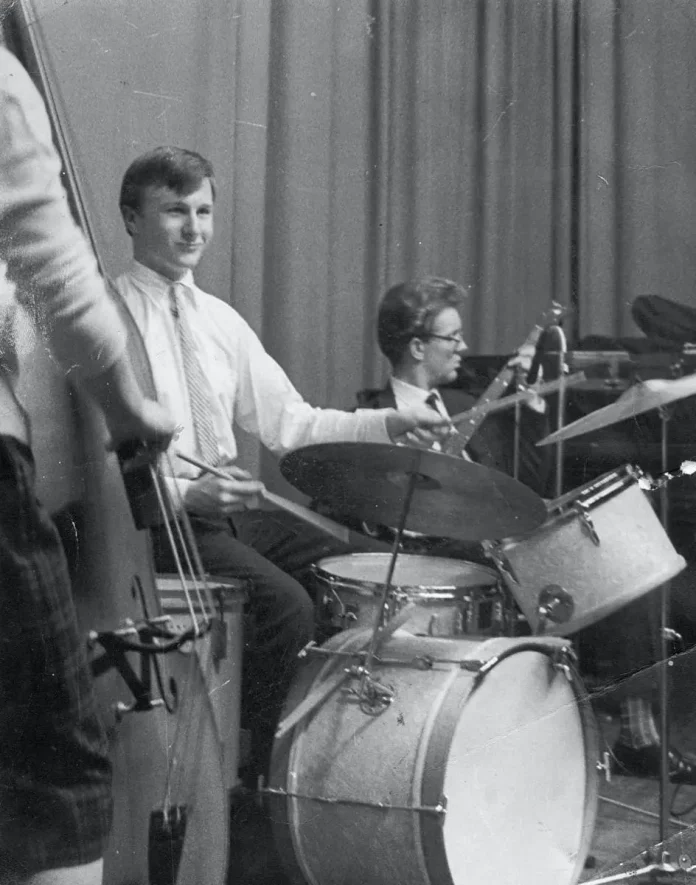The Brian “Freddie” Foskett Collection at the National Jazz Archive (NJA) in Essex is one of the country’s most important collections of jazz photography. Spanning post-war jazz through the rise of rock and pop in the mid-1960s, the collection also documents the local reception of American jazz during an age of musical transition.
Brian Foskett (1940-2017) grew up in rural Cambridgeshire where an early interest in the piano soon turned to the drums. His artistic talents were obvious but lacking the qualification to enter art school, Foskett moved in 1956 to work at Miller’s Cambridge music and record shop. Here he indulged his interest in jazz with the many students and American servicemen who used the store. He toured with the Footlights Review as a drummer in 1965, later joining the Riverside Jazz Band and other local traditional outfits.
After leaving Miller’s to become official photographer with an aircraft company, he spent his nights visiting the London jazz clubs. Later, he travelled more widely to photograph jazz musicians in continental Europe and the United States.
The NJA collection spans the period 1959 to 2018. It includes many of the great international jazz artists including Nat King Cole, Frank Sinatra, Dizzy Gillespie, Duke Ellington, Harry “Sweets” Edison and Foskett’s favourite singer, Peggy Lee. There are portraits of B. B. King and John Lee Hooker as well as performers from the world of pop and rock including the Rolling Stones, Bill Haley and Cliff Richard and The Shadows.
The most striking feature of the Foskett collection is the predominance of images of individual musicians playing live on stage. Foskett was not slow to take advantage of the more relaxed conditions at the time made which made it easier for photographers to shoot during performance, often crouched shoulder-to-shoulder with professionals in the front of the stage.
Foskett appears to be striving to show us the artists in their own world of performance, a space they made entirely their own
Whether taken during a club performance like that of Buck Clayton or in the august surroundings of the Royal Albert Hall in the case of late-career photograph of Oscar Peterson, Foskett appears to be striving to show us the artists in their own world of performance, a space they made entirely their own.
Although his emphasis would always be on live performance, Foskett never ignored the possibilities of informal portraits afforded by backstage or other less formal access. Grabbed as she left the Pigalle Club, his portrait of Peggy Lee has often been admired while that of Duke Ellington signing an autograph is a rare glimpse in Foskett’s collection of interactions between musicians and fans.
Foskett’s image of Ronnie Scott portrays a musician whose life-long commitment made him a pioneering figure in British modernist jazz in the 1950s and 60s. He knew that capturing the musician in the act of creation meant seizing on that fleeting moment, as Scott himself observed: “The attraction that jazz musicians have for photographers is understandable when one considers that both are concerned with the moment. . . This affinity seems specifically confined to jazz music.”
Foskett’s life was shaped by the coinciding passions of jazz and photography. He was always more concerned with his personal interests than money. His motivation was his love of the music and the medium. He was reticent about showing his work so one of jazz’s most devoted and talented documentarians has remained largely overlooked until now.
Foskett made his first, smaller donation to the NJA between 2013 and 2015. This included 35mm negatives covering the period 1961-1989 and North Sea Jazz Festival negatives and programmes from 1989-2006 and 2009. He bequeathed the remainder of his entire jazz photography and ephemera collection to the NJA and this material was handed over to the archive by his sister, Jan Ditheridge, in 2018. Alongside nearly 7000 prints and accompanying 35mm negatives, the collection includes programmes, concert tickets, press cuttings, obituaries, letters and record covers.
The NJA started cataloguing and digitising the photos in early 2019; and, as images are processed, they added to the NJA’s website to be available for public inspection and enjoyment. To date, 6900 prints have been catalogued and re-housed in archival sleeves and boxes. 2000 have been digitised and a selection of 265 images made available on the NJA site.
Alan John Ainsworth’s most recent book is Sight Readings: Photographers And American Jazz, 1900-1960 (Intellect/University of Chicago Press)
















